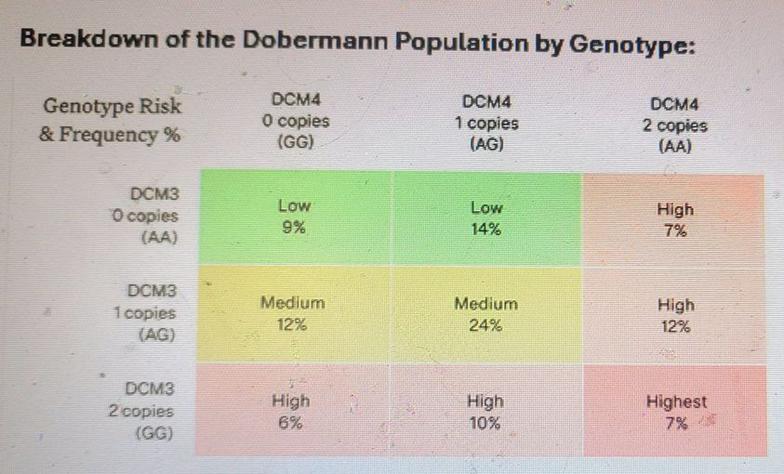DanBar Ranch
What YOU NEED To Know About Dilated Cardiomyopathy (DCM) PAGE 2
WHAT YOU NEED TO KNOW ABOUT DCM TESTING BEFORE BUYING A DOBERMAN!
PART 2 USING THE RESULTS
Using DCM3 and DCM4 test results:
Risk Definitions:
Based on the rate of development of DCM in the study dogs, we have developed the following risk categories for ease of interpretation. Please note that even dogs that carry no copies of the DCM3 and DCM4 variants are still at risk for DCM due to the complex and multifactorial nature of the disease, but at much lower risk than other categories.
Low risk: 0-50% likely to develop DCM in their lifetime
Medium risk: 51-75% likely to develop DCM in their lifetime
High risk: 76-99% likely to develop DCM in their lifetime
Highest risk: 100% likely to develop DCM in their lifetime
What to do in the breed as a whole?
Due to the limited number of dogs with zero copies of either DCM3 or DCM4 variants (Note from Diane, I own THREE!!!) and the complex nature of DCM, breeders should seek to slowly reduce the frequency of highest-risk dogs over many generations. By doing this, the good features and genetics of the highest risk dogs can be safely passed on to future litters while incrementally decreasing the risk of development of DCM in the near term. The goal of eliminating all risk factor carriers from the population is tempting in light of the severity of the disease, but this risks the overuse of some sires, formation of population bottlenecks and loss of genetic diversity in the breed. Each breeding decision will therefore need to be customised and, ideally, made in light of the health of the whole breed.
What to do in individual breeding programs?
A dog should not be excluded from breeding on the basis of a risk panel but on a holistic evaluation of their merit to the breed. Carriers, including high and highest risk dogs, should be matched with complementary dogs in order to bring about slow, positive progress toward all low-risk litters without losing bloodlines. DCM4 has a stronger influence on risk and a recessive inheritance. It is therefore recommended that breeders first focus on lowering DCM4 frequency in the breed, while balancing other DCM risk factors.
The table below shows some example matings, aiming to lower the risk in the offspring where possible, even when one of the parents is a high or medium risk individual.
Parent 1
(genotype DCM3/DCM4)
Parent 2
(genotype DCM3/DCM4)
Possible genotypes of puppies (percentages are what would be expected on average)
AA/GG
0/0 copies AA/GG
0/0 copies 100% low risk (AA/GG or 0/0 copies)
AA/GG
0/0 copies AA/AG
0/1 copies 100% low risk (50% AA/AG or 0/1 copies, 50% AA/GG or 0/0 copies)
AA/GG
0/0 copies AA/AA
0/2 copies 100% low risk (AA/AG or 0/1 copies)
AA/GG
0/0 copies AG/GG
1/0 copies 50% low risk (AA/GG or 0/0 copies), 50% medium risk (AG/GG or 1/0 copies)
AA/GG
0/0 copies GG/GG
2/0 copies 100% medium risk (AG/GG or 1/0 copies)
AA/GG
0/0 copies AG/AG
1/1 copies 25% low risk (AA/GG or 0/0), 25% medium risk (AG/GG or 1/0 copies), 25% low risk (AA/AG or 0/1 copies), 25% medium risk (AG/AG or 1/1 copies)
AG/GG
1/0 copies AA/AG
0/1 copies 25% low risk (AA/GG or 0/0 copies), 25% medium risk (AG/GG or 1/0 copies), 25% low risk (AA/AG or 0/1 copies), 25% medium risk (AG/AG or 1/1 copies)
GG/GG
2/0 copies AA/AG
0/1 copies 50% medium risk (AG/GG or 1/0 copies), 50% medium risk (AG/AG or 1/1 copies)
GG/AA
2/2 copies AA/GG
0/0 copies 100% medium risk (AG/AG or 1/1 copies)
GG/GG
2/0 copies AG/GG
1/0 copies 50% medium risk (AG/GG or 1/0 copies), 50% high risk (GG/GG or 2/0 copies)



